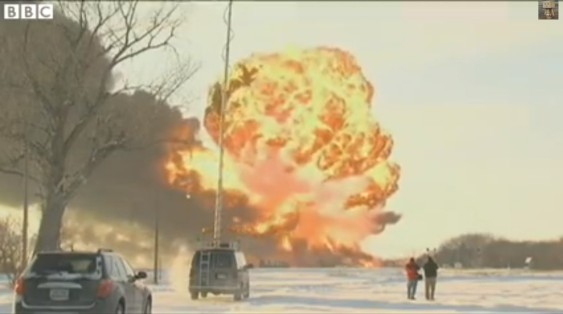Oil trains are not safe—a string of cinematic explosions has made that clear—and they’re not nearly as tightly regulated as they should be. This regulatory lapse isn’t just a one-off failure of the federal agencies charged with oversight; we’re in a jam that’s been decades in the making. Since Ronald Reagan, in fact.
When the feds released draft rules for oil trains this past July, they also published a draft Regulatory Impact Analysis (RIA). Though it’s technical and often-overlooked, the RIA is a hugely important document that weighs the benefits to the public against the costs to the private sector of new rules—rules that might require tank car upgrades, train braking improvements, safer rail routing, and speed restrictions. This cost-benefit analysis for federal rules designed to protect people and the environment has long been a tactic favored business conservatives, and it’s been the law of the land since 1982 when then-President Reagan required by executive order that federal rules pass a cost-benefit test.
In 1993, President Bill Clinton affirmed and expanded Reagan’s regulatory legacy with Executive Order 12866, so that nowadays agencies must quantify the anticipated present and future benefits and costs as accurately as possible—and then proceed with a new rule only if the benefits justify the costs. All of which may sound sensible enough, but consider this: that means the benefit of you being alive is evaluated in the same equation that measures the oil industry’s profit margin. And with exploding trains, that’s not just hyperbole.
You may think it is essential to avoid an American city repeat of the Lac-Mégantic disaster that killed 47 innocent people. But in the federal regulatory world, the merits of preventing this sort of “high-consequence event” are reduced to an accounting question. Safer oil trains have costs (to the private sector) that must be entered in the ledger opposite the benefits of saving people, property, and the environment.
The Regulatory Impact Analysis goes about setting down values for each of these benefits. For example, the US Department of Transportation established a 2014 Value of Statistical Life of $9.2 million based on expected average lifetime incomes. So in the cold calculus of the cost-benefit analysis, preventing the loss of 47 lives involved in an accident similar to Lac-Mégantic is a matter of arithmetic: 47 x $9.2 million = $432.4 million. Enter that in the benefit column along with the expected number of other accidents over the period studied, and then tally the costs of preventing accidents in the other. (By the way, the overseeing federal agency estimates that the US could experience one mega derailment and nine “high consequence events” over 20 years.)

Screen shot of BBC footage of ND oil train explosion. Screen shot of BBC footage of ND oil train explosion.
The cost-benefit analysis is not just a theoretical exercise. It shapes what regulators will consider in a regulation, knowing that they are allowed to proceed with a new rule only if the quantifiable benefits justify the quantifiable costs.
These cost-benefit constrained choices dictate the world that we live in now in many unseen ways. For example, as the New York Times reported in 2005, the Bush administration rejected a plan to double the roof strength of new automobiles, which the Transportation Department estimated might prevent 135 deaths in rollover accidents each year. Officials justified their rejection on the grounds that the costs (to the private sector) of the roofs exceeded the value of the lives saved by close to $800 million. Instead, the agency proposed a more modest increase in roof strength that would save fewer lives.
For its part, the Obama administration has gone along with the cost-benefit approach to regulations. However, by increasing the Value of a Statistical Life in the accounting formula, officials were able to justify the stricter and more expensive roof-strength standards because the re-calculated benefits outweigh the costs.
It’s much the same story for it rail cars and oil trains. For example, it appears that a cost-benefit analysis was behind regulators’ choice to apply the proposed rule only to trains comprised of 20 or more tank cars carrying highly hazardous flammable liquids. It’s a major loophole that allows oil shippers to use unsafe legacy DOT-111s—the “Ford Pinto of rail cars”—to transport volatile Bakken crude, just as long as the trains are pulling 19 or fewer tank cars. It’s an approach that is manifestly risky to the public, but because it lowers costs for the industry, it meets the requirements of the RIA. By contrast, Canadian regulators, who are not as bound by Reagan’s cost-benefit analysis requirements, proposed a comprehensive phase-out of all unsafe legacy DOT-111s transporting flammable liquids.
The federal government will consider thousands of comments on its proposed rule before agencies issue a final rule in 2015.
How much is it worth to save a life or preserve an unspoiled beach from an oil train derailment? Priceless, you might think. But thanks to Ronald Reagan and Bill Clinton, they are just credits worth no more than the debits of private industry costs.










